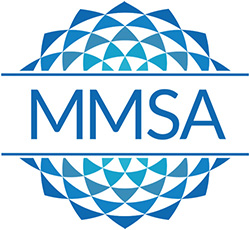While learning about different kinds of angles, I had asked my students to find examples around the classroom. We then thought, ” Where else we might find them ‘in real-life’ ?” The obvious next step was to look outside.
I like to have students use non-standard measuring tools to estimate dimensions (something many of us have done in a pinch). So before we headed out, I posed the question, “If you do not have a protractor, what else might you use?” Your hand was one of the responses.
Students had already estimated that the angle made by their thumb and index finger was about 90º. We measured it with a protractor to see how close each student’s hand was, wrote it down and then headed into the woods.
Each student had a recording sheet with their hand angle measure on the top and a table for recording objects and their angle measures. They ran excitedly about the woods measuring things such as veins on leaves, branches on a tree , veins on a rock and boards on the bridge. A few brave souls tried measuring branches high above their heads and the angle formed by two tree trunks in the distance.
Initially, they began with just 90º and 45º angles, but then they wanted to measure whatever angle they could find. Thus we had a short problem-solving session on breaking 90 and 45 into smaller measures or adding onto the 90. It did not take the students long to fine-tune a process between themselves. Armed with this knowledge, off they went to try it.
Some students asked for a challenge, so I told them to look for objects that contained more than one angle, such as a leaf. Students used added and subtracted angle measurements to create acute, right, obtuse and straight angles. Once other students saw this happening, they began to challenge each other to find ways to create specific angle measurements. A bit of a scavenger hunt was created!
Once we had finished our activity, the students began to brainstorm other measurement activities we might do on our next trip into the woods. Math outside never fails to spark their imaginations.
Cheryl-Lynne Finlay,
Meroby Elementary, 4th grade


